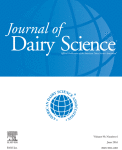Ver ítem
- xmlui.general.dspace_homeCentros Regionales y EEAsCentro Regional Santa FeEEA ReconquistaArtículos científicosxmlui.ArtifactBrowser.ItemViewer.trail
- Inicio
- Centros Regionales y EEAs
- Centro Regional Santa Fe
- EEA Reconquista
- Artículos científicos
- Ver ítem
Effect of quebracho-chestnut tannin extracts at 2 dietary crude protein levels on performance, rumen fermentation, and nitrogen partitioning in dairy cows
Resumen
Our objective was to determine the effects of a tannin mixture extract on lactating cow performance, rumen fermentation, and N partitioning, and whether responses were affected by dietary crude protein (CP). The experiment was conducted as a split-plot with 24 Holstein cows (mean ± standard deviation; 669 ± 55 kg of body weight; 87 ± 36 d in milk; 8 ruminally cannulated) randomly assigned to a diet of [dry matter (DM) basis] 15.3 or 16.6% CP (whole plot)
[ver mas...]
Our objective was to determine the effects of a tannin mixture extract on lactating cow performance, rumen fermentation, and N partitioning, and whether responses were affected by dietary crude protein (CP). The experiment was conducted as a split-plot with 24 Holstein cows (mean ± standard deviation; 669 ± 55 kg of body weight; 87 ± 36 d in milk; 8 ruminally cannulated) randomly assigned to a diet of [dry matter (DM) basis] 15.3 or 16.6% CP (whole plot) and 0, 0.45, 0.90, or 1.80% of a tannin mixture in three 4 × 4 Latin squares within each level of CP (sub-plot). Tannin extract mixture was from quebracho and chestnut trees (2:1 ratio). Dietary CP level did not influence responses to tannin supplementation. A linear decrease in DM intake (25.5 to 23.4 kg/d) was found, as well as a linear increase in milk/DM intake (1.62 to 1.75) and a trend for a linear decrease in fat-and-protein-corrected milk (38.4 to 37.1 kg/d) with increasing levels of tannin supplementation. In addition, there was a negative linear effect for milk urea N (14.0 to 12.9 mg/dL), milk protein yield (1.20 to 1.15 kg), and concentration (2.87 to 2.83%). Furthermore, the change in milk protein concentration tended to be quadratic, and predicted maximum was 2.89% for a tannin mixture fed at 0.47% of dietary DM. Tannin supplementation reduced ruminal NH3-N (11.3 to 8.8 mg/dL), total branched-chain volatile fatty acid concentration (2.97 to 2.47 mol/100 mol), DM, organic matter, CP, and neutral detergent fiber digestibility. Dietary tannin had no effect on intake N (587 ± 63 g/d), milk N (175 ± 32 g/d), or N utilization efficiency (29.7 ± 4.4%). However, feeding tannin extracts linearly increased fecal N excretion (214 to 256 g/d), but reduced urinary N (213 to 177 g/d) and urinary urea N (141 to 116 g/d) excretion. Decreasing dietary CP did not influence milk production, but increased N utilization efficiency (milk N/N intake; 0.27 to 0.33), and decreased milk urea N (15.4 to 11.8 mg/dL), ruminal NH3-N (11.0 to 9.3 mg/dL), apparent digestibility of DM (66.1 to 62.6%), organic matter (68.2 to 64.3%), and CP (62.9 to 55.9%), as well as urinary N excretion (168 vs. 232 g/d). Results of this study indicated beneficial effects of 0.45% tannin extract in the diet on milk protein content. Increasing tannin extract levels in the diet lowered urinary N excretion, but had detrimental effects on DM intake, milk protein content, milk protein yield, and nutrient digestibility.
[Cerrar]

Autor
Aguerre, Matias J.;
Capozzolo, María Cecilia;
Lencioni, P.;
Cabral, Claudio;
Wattiaux, Michael André;
Fuente
Journal of Dairy Science 99 (6) : 4476-4486 (June 2016)
Fecha
2016-06
Editorial
Elsevier
ISSN
0022-0302
1525-3198
1525-3198
Formato
pdf
Tipo de documento
artículo
Palabras Claves
Derechos de acceso
Abierto
 Excepto donde se diga explicitamente, este item se publica bajo la siguiente descripción: Creative Commons Attribution-NonCommercial-ShareAlike 2.5 Unported (CC BY-NC-SA 2.5)
Excepto donde se diga explicitamente, este item se publica bajo la siguiente descripción: Creative Commons Attribution-NonCommercial-ShareAlike 2.5 Unported (CC BY-NC-SA 2.5)


